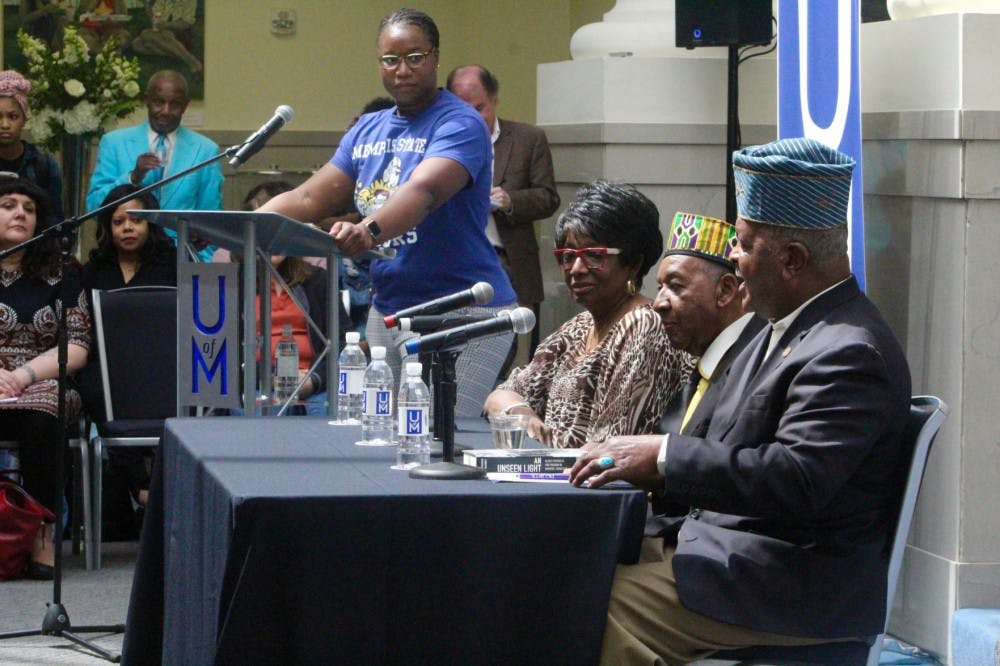
Shirletta Kinchen, author of “Black Power in the Bluff City: African American Youth and Student Activism in Memphis” moderated a panel with Carolyn Goodwin-Wilett (seated left), David Acey (seated center) and James De’Ke Pope (seated right) about the 1969 sit-in led by the UofM Black Student Association.
In the spring of April 1969, 75 Black Student Association members at the University of Memphis staged a sit-in. The sit-in included 75 students surrounding then-university president C.C. Humphreys’ office. The events that transpired on that day were commemorated on April 12 of this year in a panel discussion with members from the sit-in moderated by Shirletta Kinchen. Kinchen authored the book “Black Power in the Bluff City: African American Youth and Student Activism in Memphis,†which covers the 1969 UofM BSA sit-in and other historical events in Memphis.Â
The sit-in was ignited by Humphreys’ refusal to provide $1,750 to bring United States Rep. Adam Clayton Powell Jr., the first black person to be elected to Congress, to speak for the Black Student Association at the UofM. The sit-in eventually resulted in the police disassembling the protest.Â
The first disassembling would lead to the BSA garnering extra support from the NAACP Memphis chapter and the Community on the Move for Equality (COME). COME had been active in supporting the 1,300 sanitation strikers the year before.Â
With help from the outside organizations, the students staged a second sit-in on April 28, 1969. A total of 109 students occupied Humphreys’ office. Similar to the last protest, the police were called to disassemble this gathering. This time the students refused to leave, and all 109 were both charged and jailed. While the charges were eventually dismissed, black students continued to demand integration within campus life. The first president of the BSA, David Acey, described his experience of the event.
“I came here in 1965, and it was terrible,†Acey said. “My first semester, there was less than 100 students here. We had no participation in any of the social activity here. No football players, no teachers, no workers in the library.â€
Ignited with ambition to change the climate at the UofM, Acey teamed up with James De’Ke Pope and other students.
“I met a few people and said we need start a Black Student Association,†Acey said. “They (The UofM) didn’t want us to name it ‘Black Student Association,’ but we told them we were in charge of ourselves. You can’t tell us what to do. So, we are going to call it the Black Student Association.â€Â
James De’Ke Pope, the second president of BSA, said he can remember how the BSA helped those in the community.
“I wanted to establish a relationship with high schools, especially those that mentioned they were interested in Memphis State,†Pope said. “We started a summer school for those coming in where there were book exchanges.â€
Carolyn Goodwin-Willett expressed her feelings on being back in the place she once protested.
“I had the opportunity to come back to this campus in 2004 and work on my Master’s,†Goodwin-Willett said. “(It was a) totally different experience from when I was here in 1966. I was a scared student. I was 17 years old, and you were going into classrooms where the entire class would look to the other side of the room. And you were the only black student in there. It was scary. We didn’t have a lot of choices. Most of us were first generation for our family, and they were dependent on us.â€
Despite her undergraduate experience being full of fear, when Goodwin-Willett looks back, she said she is happy about diversity and inclusion the BSA created.
“I look at the doors we opened when we came here,†Goodwin-Willett said. “We opened doors to have a BSA. We opened doors and had the first black professor here. Not only did we open the doors for the black professor, but when she came, she held the door open.â€Â






